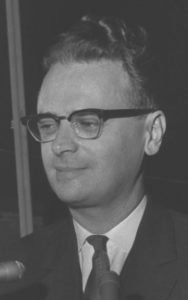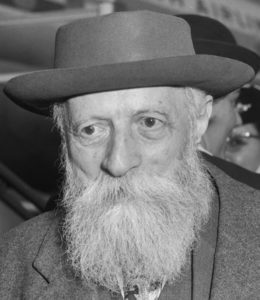Israel’s Hasidic National Poet
 Shaina Zelda Schneersohn (1914-1984) was born in what is now Ukraine, then part of the Russian Empire, to a religious family of Chabad Hasidim. She was a first cousin of the Lubavitcher Rebbe. An only child, she made aliyah with her parents when she was 12. The family settled in Jerusalem, where Zelda went on to study at the city’s Bezalel Academy of Arts in the hopes of being a professional painter. She ultimately became a teacher and taught at school in Tel-Aviv, Haifa, and Jerusalem. (One of her students was renowned writer Amos Oz). Meanwhile, she wrote poems and essays for local newspapers, and slowly gained a large following of fans. After marrying Hayim Mishkovsky, Zelda became a full-time writer and poet. She published her first collections of poems in 1967, blending themes from both Israel and Russia, infused with religious symbols and mystical concepts from Kabbalah and Hasidism, often mixing Modern Hebrew with Biblical Hebrew and Yiddish. The poems were hugely popular across Israel’s social, political, and religious spectrum. She went on to publish five more collections of poetry over the next two decades, each reaching bestseller status. She became affectionately known in Israel simply as “Zelda”, going on to win the Brenner Prize in 1971, and the Bialik Prize in 1978. Her poem “Each Person Has a Name” is publicly recited in Israel on Holocaust Remembrance Day (which also happens to be her yahrzeit). Like her cousin the Lubavitcher Rebbe (with whom she kept a regular correspondence), Zelda never had children, but had many devoted students and foster daughters that she took into her home. She is recognized today as one of Israel’s greatest poets.
Shaina Zelda Schneersohn (1914-1984) was born in what is now Ukraine, then part of the Russian Empire, to a religious family of Chabad Hasidim. She was a first cousin of the Lubavitcher Rebbe. An only child, she made aliyah with her parents when she was 12. The family settled in Jerusalem, where Zelda went on to study at the city’s Bezalel Academy of Arts in the hopes of being a professional painter. She ultimately became a teacher and taught at school in Tel-Aviv, Haifa, and Jerusalem. (One of her students was renowned writer Amos Oz). Meanwhile, she wrote poems and essays for local newspapers, and slowly gained a large following of fans. After marrying Hayim Mishkovsky, Zelda became a full-time writer and poet. She published her first collections of poems in 1967, blending themes from both Israel and Russia, infused with religious symbols and mystical concepts from Kabbalah and Hasidism, often mixing Modern Hebrew with Biblical Hebrew and Yiddish. The poems were hugely popular across Israel’s social, political, and religious spectrum. She went on to publish five more collections of poetry over the next two decades, each reaching bestseller status. She became affectionately known in Israel simply as “Zelda”, going on to win the Brenner Prize in 1971, and the Bialik Prize in 1978. Her poem “Each Person Has a Name” is publicly recited in Israel on Holocaust Remembrance Day (which also happens to be her yahrzeit). Like her cousin the Lubavitcher Rebbe (with whom she kept a regular correspondence), Zelda never had children, but had many devoted students and foster daughters that she took into her home. She is recognized today as one of Israel’s greatest poets.
Purim Begins This Saturday Night – Chag Sameach!
3 Quran Verses Every Jew Must Know
Words of the Week
We are immersed in an evolving, ongoing conflict: an Information World War in which state actors, terrorists, and ideological extremists leverage the social infrastructure underpinning everyday life to sow discord and erode shared reality.
– Renée DiResta

 Ferenc Hoffman (1924-2005) was born in Budapest, Hungary to a secular Jewish family. He loved to write from a young age, and won a prize for a novel he wrote while still in high school. He was also an avid chess player. During World War II, he was first expelled from university before being imprisoned at a number of concentration camps, ending up in the Sobibor death camp. One of the ways he survived is by challenging the guards to chess matches. Another is by maintaining his sense of humour. After the Holocaust, he went by the name Franz Kishunt, studying sculpting and art history while also writing satire. In 1949, he escaped communist Hungary and made aliyah, becoming “Ephraim Kishon”. He was a passionate Zionist and would staunchly defend the State of Israel for the rest of his life—often being disparaged by the media for his hardline views. Within two years of settling in the Holy Land, Kishon was fluent in Hebrew (he literally hand-copied an entire dictionary) and began writing satire for a number of papers. His most famous column was Had Gadya in the Ma’ariv newspaper, which he wrote almost daily for over 30 years. Kishon soon became Israel’s greatest and most famous humourist. He also wrote popular plays, an opera, and books that have been translated into some 40 languages, including So Sorry We Won! about the Six-Day War. In the 1960s, Kishon entered the world of film. He wrote, directed, and produced five movies, the first being the critically-acclaimed Sallah Shabbati, highlighting the struggle of Mizrachi Jewish refugees to Israel. The film won a Golden Globe and was nominated for an Oscar, making Kishon the first Israeli with that distinction. (The film also launched the international career of Israeli actor Chaim Topol, most famous for portraying Tevye in Fiddler on the Roof.) Kishon’s fourth film, The Policeman, also won a Golden Globe and was nominated for an Oscar. Not surprisingly, Kishon has been credited with opening up Israeli cinema to the world, and paving the path to Hollywood for Israelis. He won a long list of awards, including the Bialik Prize and the Israel Prize. He was a billiards champ, a pioneer in the field of computer chess, and even created a board game (“Havila Higiya”) once popular in Israel. Kishon has been called the “father of Israeli satire”, and inspired an entire generation of Israeli humourists.
Ferenc Hoffman (1924-2005) was born in Budapest, Hungary to a secular Jewish family. He loved to write from a young age, and won a prize for a novel he wrote while still in high school. He was also an avid chess player. During World War II, he was first expelled from university before being imprisoned at a number of concentration camps, ending up in the Sobibor death camp. One of the ways he survived is by challenging the guards to chess matches. Another is by maintaining his sense of humour. After the Holocaust, he went by the name Franz Kishunt, studying sculpting and art history while also writing satire. In 1949, he escaped communist Hungary and made aliyah, becoming “Ephraim Kishon”. He was a passionate Zionist and would staunchly defend the State of Israel for the rest of his life—often being disparaged by the media for his hardline views. Within two years of settling in the Holy Land, Kishon was fluent in Hebrew (he literally hand-copied an entire dictionary) and began writing satire for a number of papers. His most famous column was Had Gadya in the Ma’ariv newspaper, which he wrote almost daily for over 30 years. Kishon soon became Israel’s greatest and most famous humourist. He also wrote popular plays, an opera, and books that have been translated into some 40 languages, including So Sorry We Won! about the Six-Day War. In the 1960s, Kishon entered the world of film. He wrote, directed, and produced five movies, the first being the critically-acclaimed Sallah Shabbati, highlighting the struggle of Mizrachi Jewish refugees to Israel. The film won a Golden Globe and was nominated for an Oscar, making Kishon the first Israeli with that distinction. (The film also launched the international career of Israeli actor Chaim Topol, most famous for portraying Tevye in Fiddler on the Roof.) Kishon’s fourth film, The Policeman, also won a Golden Globe and was nominated for an Oscar. Not surprisingly, Kishon has been credited with opening up Israeli cinema to the world, and paving the path to Hollywood for Israelis. He won a long list of awards, including the Bialik Prize and the Israel Prize. He was a billiards champ, a pioneer in the field of computer chess, and even created a board game (“Havila Higiya”) once popular in Israel. Kishon has been called the “father of Israeli satire”, and inspired an entire generation of Israeli humourists. Mordechai Martin Buber (1878-1965) was born in Vienna to a religious Jewish family. His parents got divorced when he was just three years old, so Buber was raised in what was then Poland by his grandfather. Despite growing up in a richly Hasidic home, Buber began reading secular literature and returned to Vienna as a young man to study philosophy. Around the same time, he became active in the Zionist movement and soon became the editor of Die Welt, the main newspaper of Zionism. It wasn’t long before Buber became dissatisfied with the secularism and “busyness” of Zionism and returned (partially) to his Hasidic roots. He saw in Hasidic communities the right model for a new Israel, and a better alternative to the entirely-secular kibbutz. Buber ultimately saw Zionism not as a nationalist or political movement, but as a religious movement that should, first and foremost, serve to spiritually enrich the Jewish people—along with the rest of the world. He would later be credited with being the father of “Hebrew humanism” and “spiritual Zionism”. In 1908, he was invited to address a group of Jewish intellectuals known as the “Prague Circle”, and to “remind them about their Judaism”, as the group’s leader had requested. Among the members of the Circle was (former Jew of the Week)
Mordechai Martin Buber (1878-1965) was born in Vienna to a religious Jewish family. His parents got divorced when he was just three years old, so Buber was raised in what was then Poland by his grandfather. Despite growing up in a richly Hasidic home, Buber began reading secular literature and returned to Vienna as a young man to study philosophy. Around the same time, he became active in the Zionist movement and soon became the editor of Die Welt, the main newspaper of Zionism. It wasn’t long before Buber became dissatisfied with the secularism and “busyness” of Zionism and returned (partially) to his Hasidic roots. He saw in Hasidic communities the right model for a new Israel, and a better alternative to the entirely-secular kibbutz. Buber ultimately saw Zionism not as a nationalist or political movement, but as a religious movement that should, first and foremost, serve to spiritually enrich the Jewish people—along with the rest of the world. He would later be credited with being the father of “Hebrew humanism” and “spiritual Zionism”. In 1908, he was invited to address a group of Jewish intellectuals known as the “Prague Circle”, and to “remind them about their Judaism”, as the group’s leader had requested. Among the members of the Circle was (former Jew of the Week)